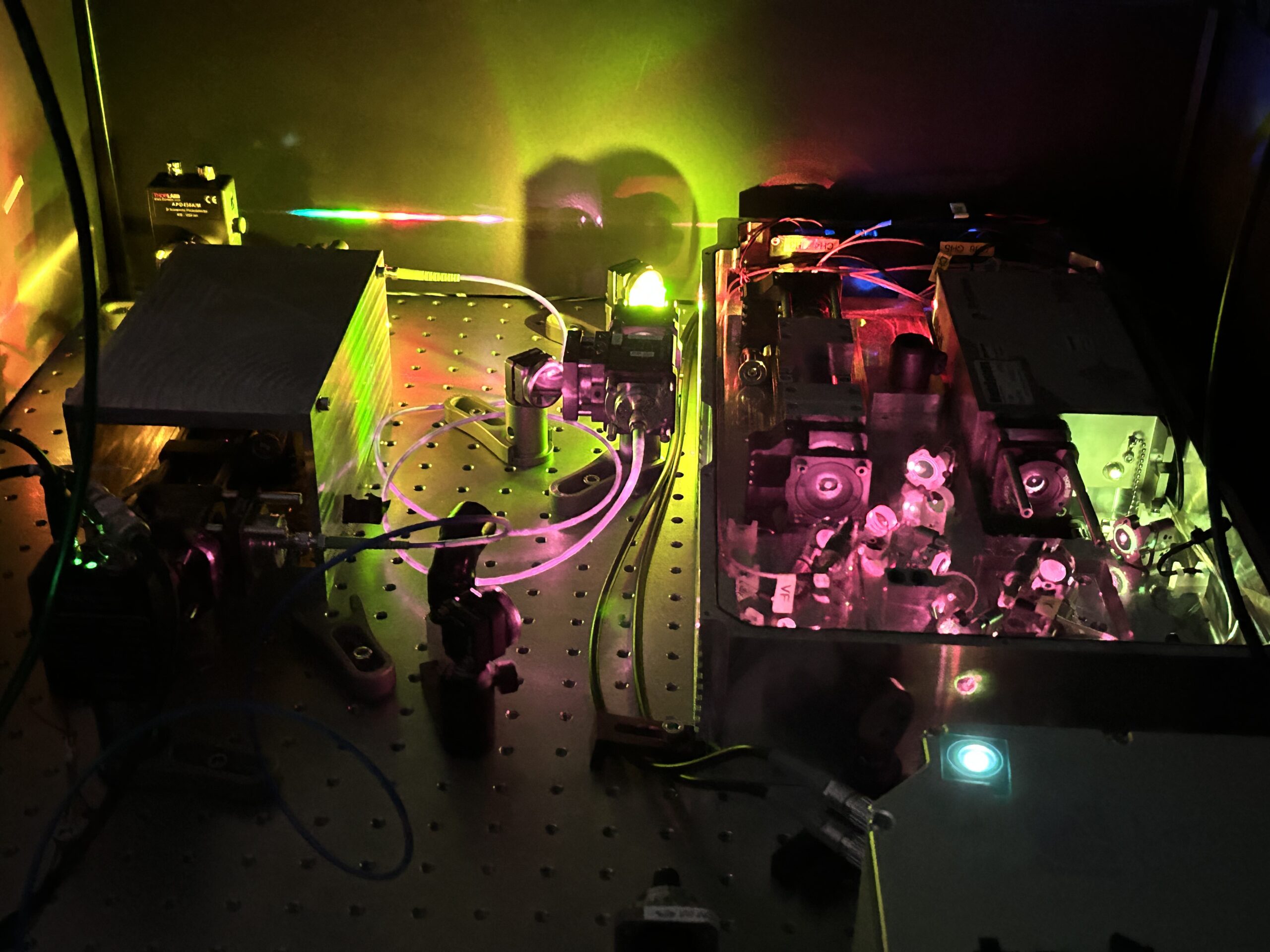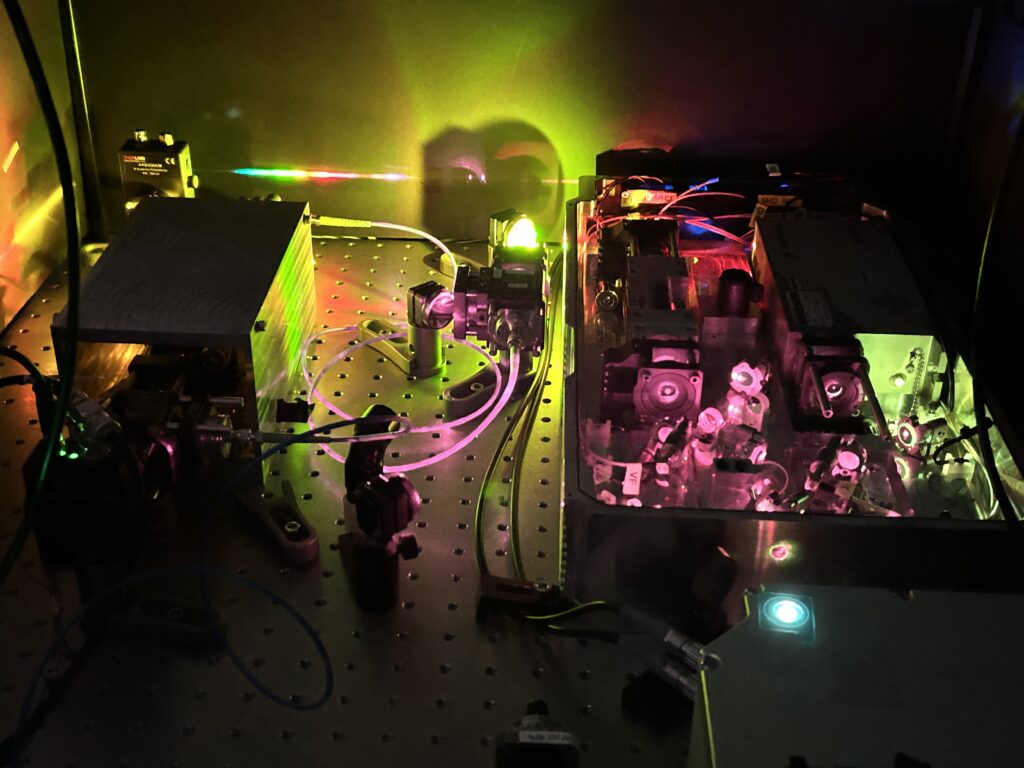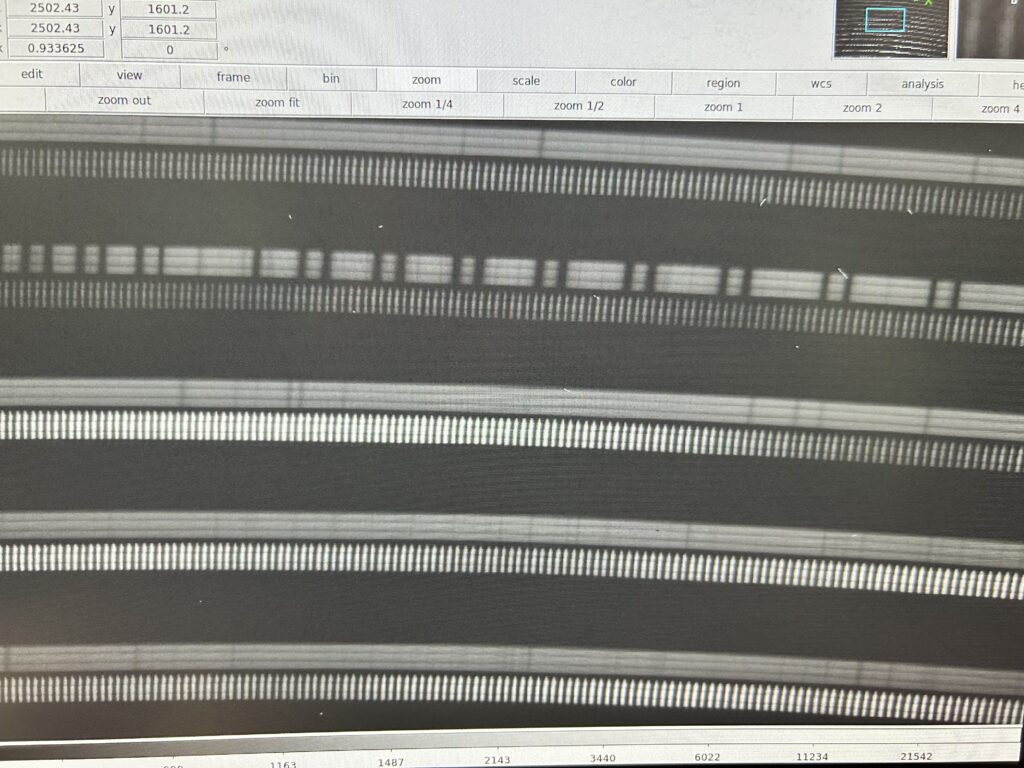
05 Jul Southern African Large Telescope gears up for precision radial velocity science, including hunting for exoplanets, with a Heriot-Watt Astrocomb
Astronomers using the Southern African Large Telescope (SALT) will soon be able to hunt for and study planets orbiting distant stars. This exciting new science capability for SALT stems from the addition of a state-of-the-art precision calibration system to enhance the high-stability mode of the telescope’s high-resolution spectrograph (HRS).
This new device, known as a laser frequency comb (LFC, or astrocomb), was designed and installed at SALT by laser experts at Heriot-Watt University (HWU) in Edinburgh. The LFC will enable the HRS to detect minute radial velocity (line-of-sight) variations in incoming starlight, one source of which is the wobble introduced by one or more planets orbiting a star. In effect, the comb will act as an incredibly finely graduated ruler that can precisely measure the wavelength (colour) of light from stars orbited by planets outside our solar system.

A glimpse inside the LFC comb module, showing the many optical components involved in generating the supercontinuum spectrum.
These are exceedingly demanding measurements to make, requiring a highly stabilised spectrograph and superb wavelength calibration. SALT’s HRS was designed with this application in mind, but additional hardware and a custom data reduction pipeline were needed to realise these ambitions. Both have been under development over the past two years, and the project team celebrated a significant milestone recently, when the comb achieved first-light on sky. A radial velocity standard star was observed with SALT, but this time with astrocomb Iight injected into the spectrograph during the observation for improved wavelength calibration precision.
This astrocomb is the culmination of years of partnership between the two groups of scientists from SALT and HWU, and it beautifully demonstrates the power of multi-disciplinary collaboration. When email introductions were first made in 2015, the HWU team had never visited a large telescope, and a laser frequency comb was far beyond SALT’s reach owing to the cost of these systems. Working together since has afforded SALT staff and students privileged access to this highly specialised technological domain, and given HWU the opportunity to test their device(s) in an operational environment on one of the world’s largest telescopes. Both camps have benefitted and evolved as a result.
Experience gathered with the experimental LFC at SALT in 2016 led to refinements in the overall design and HWU has subsequently gained traction in the astrocomb world, leading the comb development for the upcoming Extremely Large Telescope (ELT) in Chile. The SAAO mechanical workshop also contributed by machining parts for the SALT comb and the high quality of their workmanship and their relatively low hourly rates have made them the obvious choice for future machining associated with HWU astrocombs.

The LFC supercontinuum, an optical spectrum composed of countless individual laser spots that provide superior wavelength calibration for the spectrograph.
The SALT HRS LFC project is funded by the National Research Foundation in South Africa, through a collaboration between the country’s two major astronomical facilities, the South African Radio Astronomy Observatory (SARAO) and the South African Astronomical Observatory (SAAO), the latter being the optical and infrared observatory contracted to operate SALT. The astrocomb therefore represents a major in-kind contribution to the telescope by the NRF, which is also the major shareholder in the international SALT partnership that includes various universities and institutes within the USA, Poland, India and the UK.
There is still work to be done to complete the development of the LFC itself, its software interface and the data pipeline before it will be made available to SALT users, but great progress was made during the recent integration campaign at the telescope. Over the coming months, the comb will undergo testing, commissioning and science verification phases before being released to the SALT user community for full science operation.
SALT Observatory Scientist and principal investigator for the HRS upgrade project, Dr Lisa Crause, said: “The astrocomb is an incredibly exciting addition to our instrument suite, with huge implications for the HRS and SALT’s precision radial velocity capabilities. But even more significant is the fact that SALT is participating in the incubation of critical technologies needed to help advance this challenging field.”
“Laser frequency combs are ideally suited to providing precision wavelength calibration for high-resolution spectrographs, but they are notoriously expensive, complex devices to own and operate. Having HWU developing their own astrocombs opens up opportunities to test and refine new approaches and will likely lower the threshold for other telescopes to adopt these systems for ultra-precise wavelength calibration. All of which bodes well for hunting for low mass exoplanets, the Earth-like ones that we humans find the most interesting!”
“It’s an absolute treat for observatory staff to get to work with and learn from laser physicists about fascinating equipment that we’d ordinarily have no business playing with!”
Technical lead for the project, Dr Richard McCracken from Heriot-Watt University, said “Our astrocomb is driven by a titanium sapphire laser and uses photonic crystal fibres to generate a supercontinuum of light across the visible and near-infrared, from 550nm to 900nm.”
“Astrocombs produce a spectrum of hyperfine optical frequencies, each separated from one another by a fixed amount, like the teeth on a comb. We know the frequency, or colour, of each comb tooth with extreme certainty, so the astrocomb acts as an optical ruler for the spectrograph. This will allow the SALT team to measure the starlight more precisely.”
“For some exoplanets, the change in the position of a spectral line on the spectrograph due to the ‘wobble’ of the star can be less than a single pixel. Only an astrocomb can provide the frequency calibration needed to measure this change.”
“Having the new astrocomb permanently in place at SALT means we’ll be able to continuously upgrade and improve the comb, adapting it to incorporate cutting-edge technologies. It’s a very exciting prospect.”

First-light on-sky with the LFC, showing a spectrum of a radial velocity standard star alongside the calibration spectrum from the LFC.
ENDS
Download Images: LFC PR Jul 2024
Image Captions:
7575.jpg: A busy optical bench during the integration of the laser frequency comb (LFC) at SALT.
7680.jpg: Laser physicists Richard McCracken and Shan Cheng from Heriot-Watt University working on the LFC.
7706.jpg: A glimpse inside the LFC comb module, showing the many optical components involved in generating the supercontinuum spectrum.
7740.jpg: First-light on-sky with the LFC, showing a spectrum of a radial velocity standard star alongside the calibration spectrum from the LFC.
supercontinuum.jpg: The LFC supercontinuum, an optical spectrum composed of countless individual laser spots that provide superior wavelength calibration for the spectrograph.
colourful light.mov: The output spectrum of the LFC is highly sensitive to the optical alignment of the system, so we see the colours change while adjusting various components.
old vs new calibrations.mov: Comparison between the spectrograph’s original Thorium-Argon calibration spectrum and the dense array of lines produced by the new laser comb.
Media contacts:
Lisa Crause (lisa@saao.ac.za) at SAAO
Sarah McDaid (sarah@mcdaidpr.co.uk, +44 786 678 9688) at HWU
Daniel Cunnama (d.cunnama@saao.nrf.ac.za, +27 21 501 5169) at SAAO
